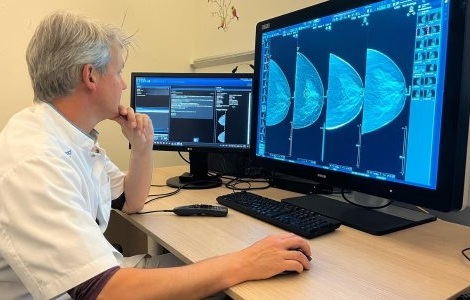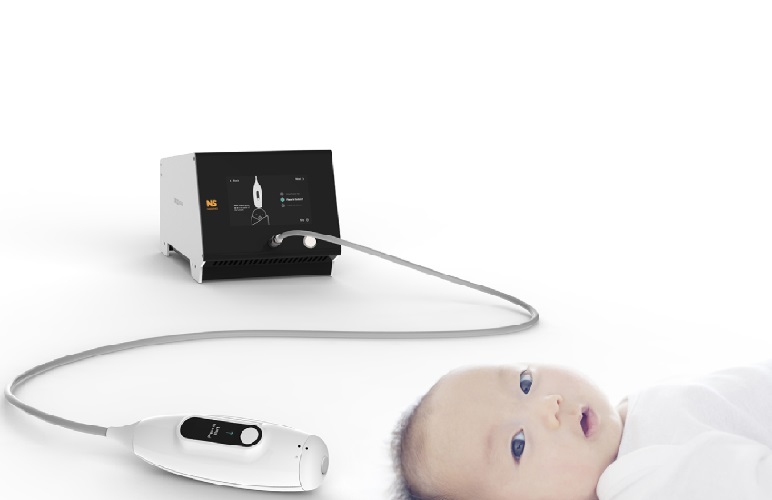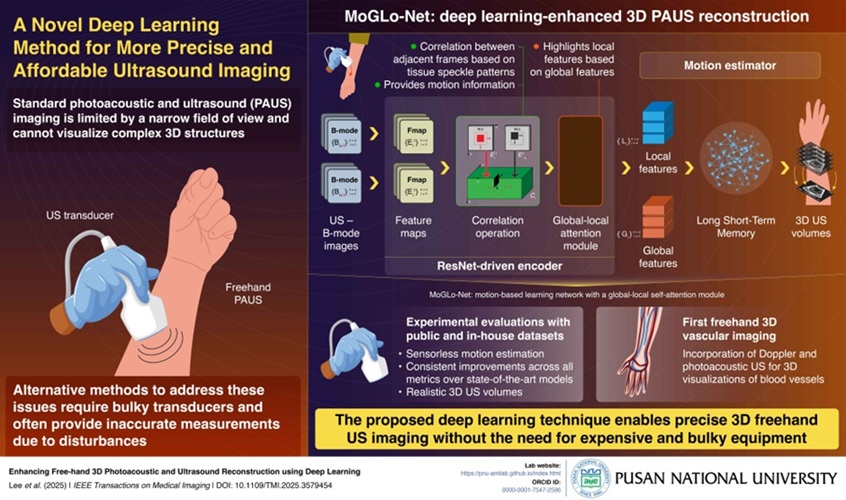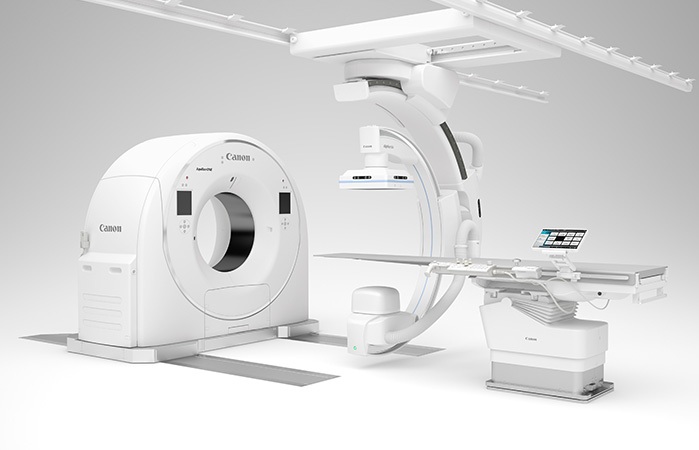MRI-Based Technology Assesses Muscle Composition 
|
By MedImaging International staff writers Posted on 21 Dec 2021 |
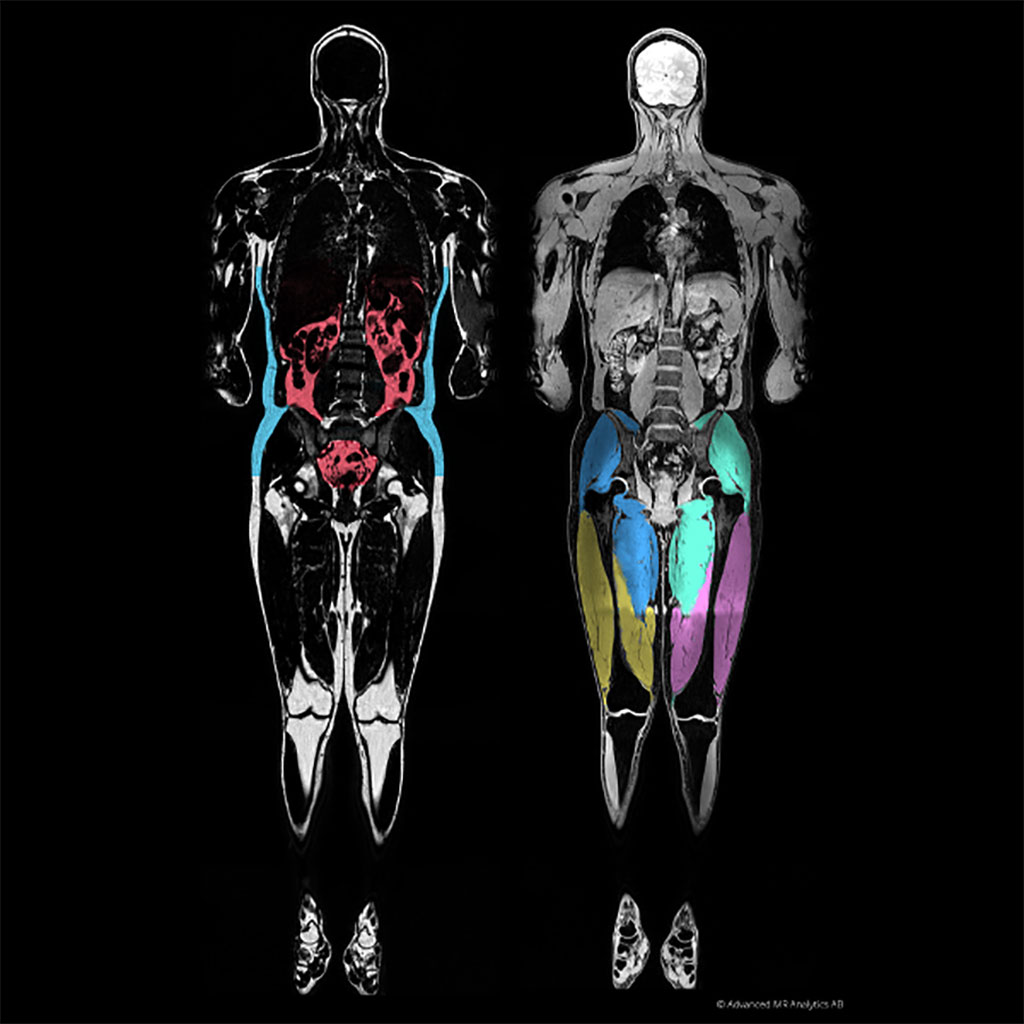
Image: A graphical MAsS score of visceral fat (L) and muscle (R) (Photo courtesy of AMRA medical)
Novel software can analyze a patient with suspected sarcopenia using a rapid neck-to-knee magnetic resonance imaging (MRI) scan.
The AMRA medical (Linköping, Sweden) Muscle Assessment Score (MAsS) Scan is designed to measure volumetric changes in muscle mass and the diffusion of fat infiltration into the muscle. The scanning protocol is based on symmetrical chemical shift imaging, also known as two-point Dixon imaging. Acquired images consist of fat and water image pairs, as reconstructed by the software. The images are automatically calibrated and corrected for variations caused by inhomogeneity in the magnetic field and coil sensitivity.
The resulting report contains the MAsS scan, anatomic and color-coded images, and precise body composition measurements with contextual insights based on AMRA's reference database. The platform-agnostic software works across all major 1.5 and 3T MR scanners, such that output across scanners is standardized and calibrated using the fat signal as an internal reference. The value of each pixel shows the percentage of fat in it; partial-volume effects do not affect quantification, and thin layers of fat (or even diffuse infiltration) contribute to fat quantification.
In addition, AMRA automates the classification and quantification of fat and muscle groups, with segmentation based on registration between the image data volume and manually segmented prototype volumes. Body fat is divided into subcutaneous, visceral, and ectopic compartments; muscle groups are automatically classified, and the volume of each individual muscle group is obtained. Additionally, the amount of fat in any user-defined region, (e.g. a muscle or an internal organ) can be calculated also for diffuse fat infiltration.
“The AMRA MAsS Scan will greatly benefit patients by allowing clinicians to assess sarcopenia and improve patient outcomes an objectively and accurately assess muscle quality and take action,” said Eric Converse, CEO of AMRA Medical. “The beauty of the report is that it is easy-to-understand, it creates a common language among clinicians with the muscle assessment score, and adds only minutes to an already prescribed MRI.”
Sarcopenia (from the Greek, meaning "poverty of flesh") is the degenerative loss of skeletal muscle mass. Sarcopenia is characterized first by muscle atrophy, along with a reduction in muscle tissue "quality," caused by such factors as replacement of muscle fibers with fat, an increase in fibrosis, changes in muscle metabolism, oxidative stress, and degeneration of the neuromuscular junction. Combined, these changes lead to progressive loss of muscle function and frailty. Sarcopenia can be thought of as a muscular analog of osteoporosis, also caused by inactivity and counteracted by exercise. The combination of osteoporosis and sarcopenia results in the significant frailty often seen in the elderly population.
Related Links:
AMRA medical
The AMRA medical (Linköping, Sweden) Muscle Assessment Score (MAsS) Scan is designed to measure volumetric changes in muscle mass and the diffusion of fat infiltration into the muscle. The scanning protocol is based on symmetrical chemical shift imaging, also known as two-point Dixon imaging. Acquired images consist of fat and water image pairs, as reconstructed by the software. The images are automatically calibrated and corrected for variations caused by inhomogeneity in the magnetic field and coil sensitivity.
The resulting report contains the MAsS scan, anatomic and color-coded images, and precise body composition measurements with contextual insights based on AMRA's reference database. The platform-agnostic software works across all major 1.5 and 3T MR scanners, such that output across scanners is standardized and calibrated using the fat signal as an internal reference. The value of each pixel shows the percentage of fat in it; partial-volume effects do not affect quantification, and thin layers of fat (or even diffuse infiltration) contribute to fat quantification.
In addition, AMRA automates the classification and quantification of fat and muscle groups, with segmentation based on registration between the image data volume and manually segmented prototype volumes. Body fat is divided into subcutaneous, visceral, and ectopic compartments; muscle groups are automatically classified, and the volume of each individual muscle group is obtained. Additionally, the amount of fat in any user-defined region, (e.g. a muscle or an internal organ) can be calculated also for diffuse fat infiltration.
“The AMRA MAsS Scan will greatly benefit patients by allowing clinicians to assess sarcopenia and improve patient outcomes an objectively and accurately assess muscle quality and take action,” said Eric Converse, CEO of AMRA Medical. “The beauty of the report is that it is easy-to-understand, it creates a common language among clinicians with the muscle assessment score, and adds only minutes to an already prescribed MRI.”
Sarcopenia (from the Greek, meaning "poverty of flesh") is the degenerative loss of skeletal muscle mass. Sarcopenia is characterized first by muscle atrophy, along with a reduction in muscle tissue "quality," caused by such factors as replacement of muscle fibers with fat, an increase in fibrosis, changes in muscle metabolism, oxidative stress, and degeneration of the neuromuscular junction. Combined, these changes lead to progressive loss of muscle function and frailty. Sarcopenia can be thought of as a muscular analog of osteoporosis, also caused by inactivity and counteracted by exercise. The combination of osteoporosis and sarcopenia results in the significant frailty often seen in the elderly population.
Related Links:
AMRA medical
Latest MRI News
- AI-Assisted Model Enhances MRI Heart Scans
- AI Model Outperforms Doctors at Identifying Patients Most At-Risk of Cardiac Arrest
- New MRI Technique Reveals Hidden Heart Issues
- Shorter MRI Exam Effectively Detects Cancer in Dense Breasts
- MRI to Replace Painful Spinal Tap for Faster MS Diagnosis
- MRI Scans Can Identify Cardiovascular Disease Ten Years in Advance
- Simple Brain Scan Diagnoses Parkinson's Disease Years Before It Becomes Untreatable
- Cutting-Edge MRI Technology to Revolutionize Diagnosis of Common Heart Problem
- New MRI Technique Reveals True Heart Age to Prevent Attacks and Strokes
- AI Tool Predicts Relapse of Pediatric Brain Cancer from Brain MRI Scans
- AI Tool Tracks Effectiveness of Multiple Sclerosis Treatments Using Brain MRI Scans
- Ultra-Powerful MRI Scans Enable Life-Changing Surgery in Treatment-Resistant Epileptic Patients
- AI-Powered MRI Technology Improves Parkinson’s Diagnoses
- Biparametric MRI Combined with AI Enhances Detection of Clinically Significant Prostate Cancer
- First-Of-Its-Kind AI-Driven Brain Imaging Platform to Better Guide Stroke Treatment Options
- New Model Improves Comparison of MRIs Taken at Different Institutions
Channels
Radiography
view channel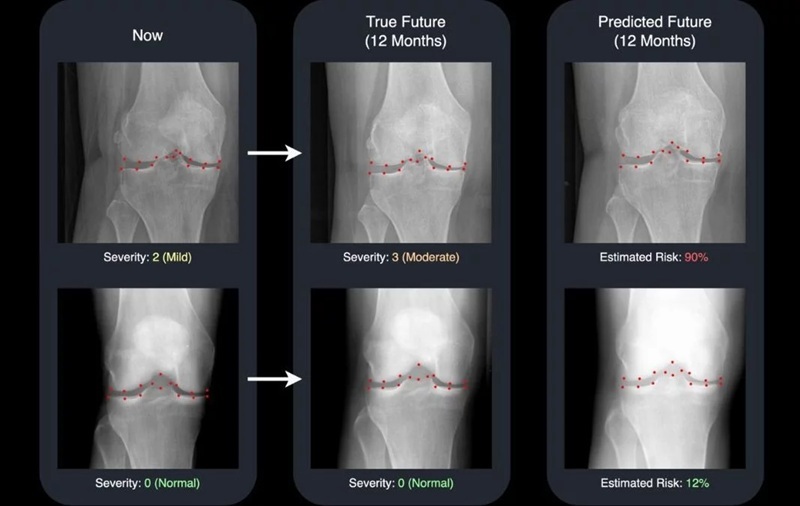
AI Generates Future Knee X-Rays to Predict Osteoarthritis Progression Risk
Osteoarthritis, a degenerative joint disease affecting over 500 million people worldwide, is the leading cause of disability among older adults. Current diagnostic tools allow doctors to assess damage... Read more
AI Algorithm Uses Mammograms to Accurately Predict Cardiovascular Risk in Women
Cardiovascular disease remains the leading cause of death in women worldwide, responsible for about nine million deaths annually. Despite this burden, symptoms and risk factors are often under-recognized... Read moreUltrasound
view channel
Ultrasound Probe Images Entire Organ in 4D
Disorders of blood microcirculation can have devastating effects, contributing to heart failure, kidney failure, and chronic diseases. However, existing imaging technologies cannot visualize the full network... Read more
Disposable Ultrasound Patch Performs Better Than Existing Devices
Wearable ultrasound devices are widely used in diagnostics, rehabilitation monitoring, and telemedicine, yet most existing models rely on lead-based piezoelectric ceramics that pose health and environmental risks.... Read moreNuclear Medicine
view channel
New Imaging Solution Improves Survival for Patients with Recurring Prostate Cancer
Detecting recurrent prostate cancer remains one of the most difficult challenges in oncology, as standard imaging methods such as bone scans and CT scans often fail to accurately locate small or early-stage tumors.... Read more
PET Tracer Enables Same-Day Imaging of Triple-Negative Breast and Urothelial Cancers
Triple-negative breast cancer (TNBC) and urothelial bladder carcinoma (UBC) are aggressive cancers often diagnosed at advanced stages, leaving limited time for effective treatment decisions.... Read more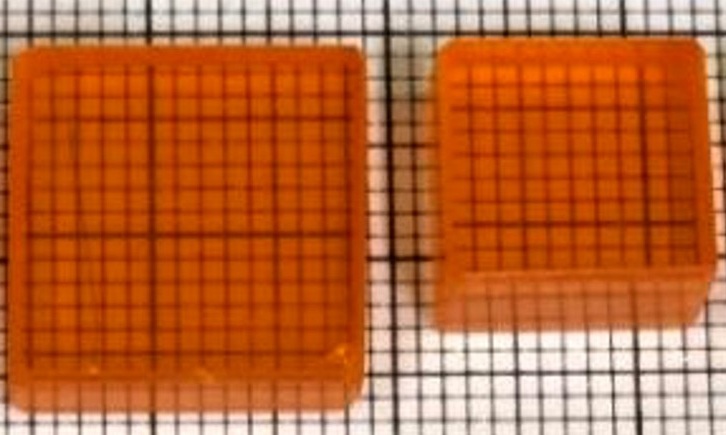
New Camera Sees Inside Human Body for Enhanced Scanning and Diagnosis
Nuclear medicine scans like single-photon emission computed tomography (SPECT) allow doctors to observe heart function, track blood flow, and detect hidden diseases. However, current detectors are either... Read more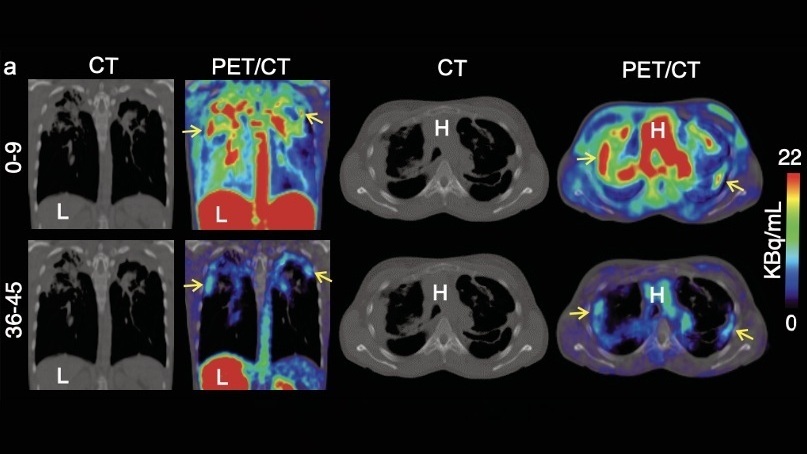
Novel Bacteria-Specific PET Imaging Approach Detects Hard-To-Diagnose Lung Infections
Mycobacteroides abscessus is a rapidly growing mycobacteria that primarily affects immunocompromised patients and those with underlying lung diseases, such as cystic fibrosis or chronic obstructive pulmonary... Read moreGeneral/Advanced Imaging
view channel
AI Tool Improves Medical Imaging Process by 90%
Accurately labeling different regions within medical scans, a process known as medical image segmentation, is critical for diagnosis, surgery planning, and research. Traditionally, this has been a manual... Read more
New Ultrasmall, Light-Sensitive Nanoparticles Could Serve as Contrast Agents
Medical imaging technologies face ongoing challenges in capturing accurate, detailed views of internal processes, especially in conditions like cancer, where tracking disease development and treatment... Read more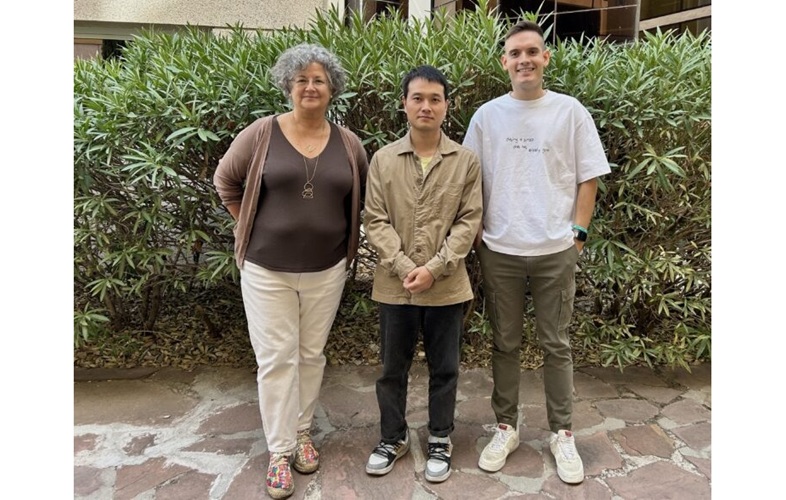
AI Algorithm Accurately Predicts Pancreatic Cancer Metastasis Using Routine CT Images
In pancreatic cancer, detecting whether the disease has spread to other organs is critical for determining whether surgery is appropriate. If metastasis is present, surgery is not recommended, yet current... Read moreImaging IT
view channel
New Google Cloud Medical Imaging Suite Makes Imaging Healthcare Data More Accessible
Medical imaging is a critical tool used to diagnose patients, and there are billions of medical images scanned globally each year. Imaging data accounts for about 90% of all healthcare data1 and, until... Read more
Global AI in Medical Diagnostics Market to Be Driven by Demand for Image Recognition in Radiology
The global artificial intelligence (AI) in medical diagnostics market is expanding with early disease detection being one of its key applications and image recognition becoming a compelling consumer proposition... Read moreIndustry News
view channel
GE HealthCare and NVIDIA Collaboration to Reimagine Diagnostic Imaging
GE HealthCare (Chicago, IL, USA) has entered into a collaboration with NVIDIA (Santa Clara, CA, USA), expanding the existing relationship between the two companies to focus on pioneering innovation in... Read more
Patient-Specific 3D-Printed Phantoms Transform CT Imaging
New research has highlighted how anatomically precise, patient-specific 3D-printed phantoms are proving to be scalable, cost-effective, and efficient tools in the development of new CT scan algorithms... Read more
Siemens and Sectra Collaborate on Enhancing Radiology Workflows
Siemens Healthineers (Forchheim, Germany) and Sectra (Linköping, Sweden) have entered into a collaboration aimed at enhancing radiologists' diagnostic capabilities and, in turn, improving patient care... Read more












